Sometimes people want a lot of power from their diesel without advertising it to the world. This 2012 Ram 2500 is used for light duty, daily driving, and towing a car trailer, so it’s not meant to turn heads by being flashy. In fact, it’s perfectly capable of staying under the radar with its white paint, stock wheels, and street tires—although we predict an upgrade to the rolling stock in the near future after seeing this burnout. Here’s how the team at Banks Power transformed this 6.7L Cummins-equipped truck from bone-stock into a super sleeper with the same tools you probably have in your garage.
Baseline Basics Before any upgrades were added to the Ram, it was strapped down to the chassis dyno to see what kind of power the truck was making. The 6.7L Cummins engine was introduced for the Ram 2500 and 3500 for the 2007½ model year. The extra displacement when compared to the 5.9L was part of a strategy to meet new federal emissions requirements while staying competitive with Ford and GM during the torque wars that are still raging today. With all the stock parts in place, this 2012 Ram 2500 was able to put down a very respectable 304 hp and 625 lb-ft of torque at the rear wheels. Not bad at all for a completely stock ¾-ton pickup.
Breathing Easy
The first steps to perking up the Cummins engine were removing the restrictive factory airbox and improving the flow of the exhaust system. The Banks Ram-Air cold-air intake for the 2007 to 2012 Ram is designed to flow up to 50 percent better than the stock intake while working seamlessly with the factory engine computer. The intake has a high-flow, washable air filter element; a streamlined interior design; and a flexible, 4½-inch bellows to prevent anything from coming apart due to engine vibrations from the large, six-cylinder engine. The 4-inch, diesel-particulate, filter-back Monster exhaust system is available in four configurations: side-single outlet, side-single with dual outlets, dual-side outlets with single tips, and side quads with two tips on each side of the truck. To keep the mostly stock appearance of this sleeper intact, the single-side outlet design was chosen and fitted with a fairly low-key, 5-inch polished round tip. Once the stock intake and exhaust had been replaced, the Ram was able to make 319 hp and 667 lb-ft of torque at the rear wheels. That’s a gain of 15 hp and 42 lb-ft of torque with the stock engine calibrations.
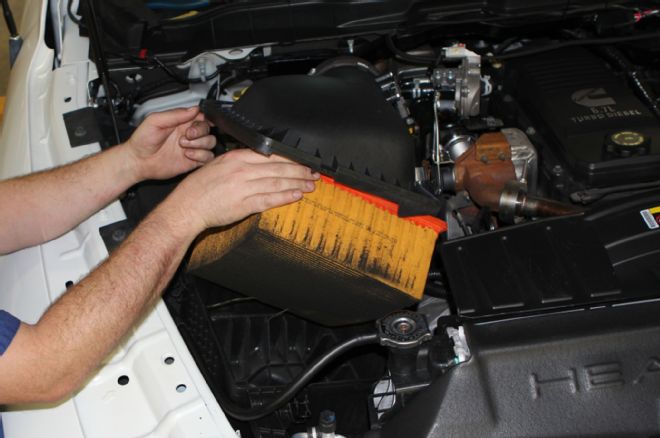
| 2012 Ram 2500 02 Stock Intake
One of the first steps for the sleeper buildup was to get rid of the restrictive factory airbox and air filter. Even with a fairly dirty air filter in place, a session on the chassis dyno proved the stock 2012 Ram 6.7L Cummins was capable of making 304 hp at 2,650 rpm and 625 lb-ft of torque at 2,250 rpm.
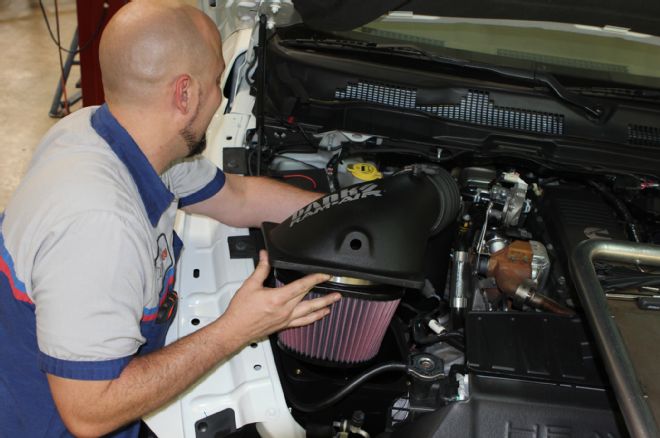
| 2012 Ram 2500 03 Banks Intake
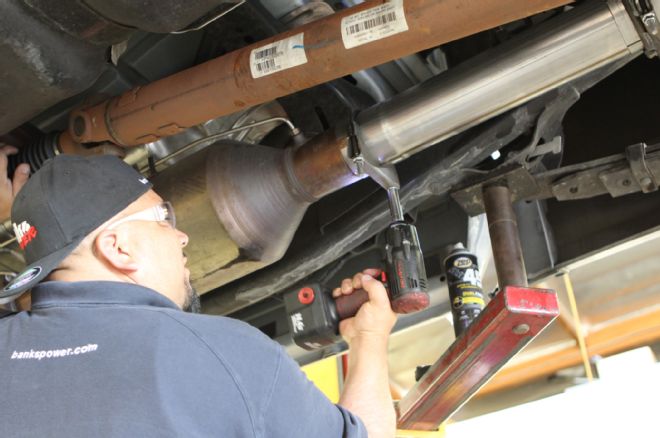
| 2012 Ram 2500 04 Exhuast
The Banks Monster exhaust for the 2012 Ram 2500 replaces everything from the diesel particulate filter back with a 4-inch-diameter, mandrel-bent tube. This setup retains the DPF, so the truck should have no problem passing a California smog test. The owner chose the single 5-inch round exhaust tip to maintain a low profile.
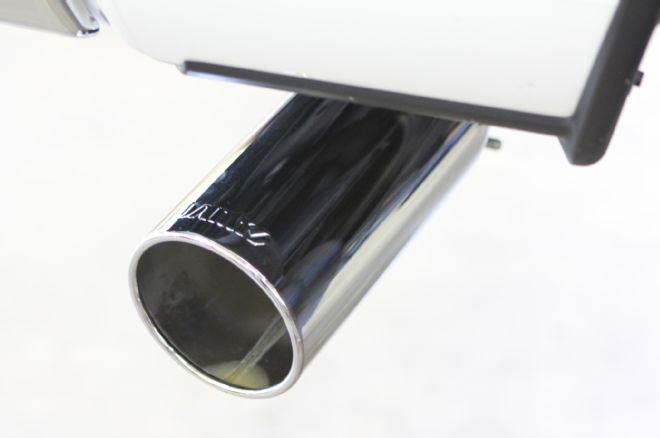
| 2012 Ram 2500 17 Exhuast
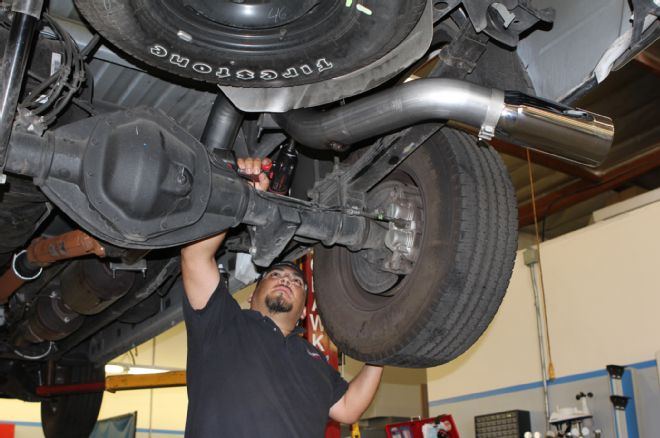
| 2012 Ram 2500 05 Exhuast
The exhaust kit chosen for the 6.7L sleeper is a single-side exhaust, but the Monster exhaust is also available with dual tips on one side of the truck, a single exhaust tip on both sides, or dual tips on both sides of the truck. With the intake and exhaust upgrades, our dyno test showed gains of 15 hp and 42 lb-ft of torque before any upgrades were made to the computer programming.
Programming for Power
With the new hard parts in place, the next step was adding an AutoMind engine programmer and a touchscreen iQ 2.0 display. The programmer comes pre-loaded with tunes and has the ability to change vehicle functions such as adjusting the engine rpm limiter, changing the cooling fan’s activation temperature, or adjusting the shift points in the 68RFE transmission, along with tons of other features. The iQ 2.0 and AutoMind work together seamlessly thanks to a network hub that tucks away inside the side panel of the dash. Once everything was wired, the Ram was put on the dyno to find out how much power it would make with the improved breathing and engine programming to take advantage of the intake and exhaust. This setup resulted in a best dyno run of 402 hp and 774 lb-ft of torque, which is a bump of 98 hp and 149 lb-ft compared to stock that’s available with a few button presses.
To take advantage of the improved airflow of the intake and exhaust, the Banks AutoMind programmer was used to recalibrate the ECU. Behind the dash panel, a Banks network hub was installed to make sure everything works in concert. With the engine tuning in effect and no fluid injection, the 6.7L Cummins was able to make 402 hp at 3,000 rpm and 774 lb-ft of torque at 2,500 rpm.
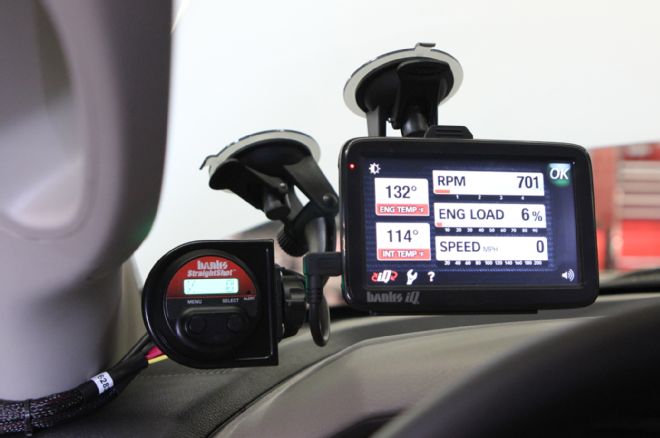
| 2012 Ram 2500 06 Banks Iq Tunner
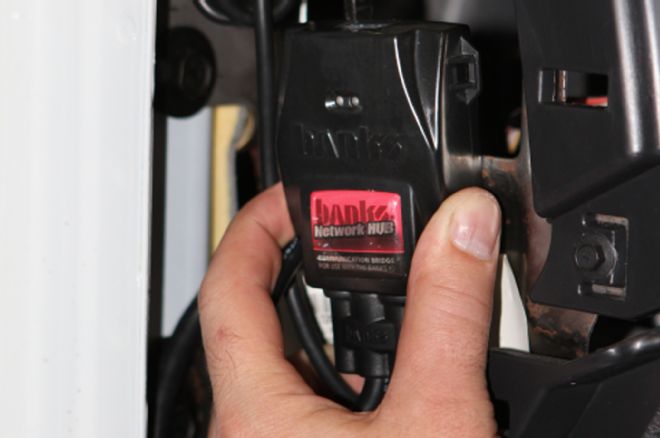
| 2012 Ram 2500 07 Banks Network Hub
Spray Down
While that power rating would be fine for most people, the team at Banks wanted to see what could be accomplished with a healthy dose of water-methanol injection from their Double-Shot system. Three ports were drilled into the intake for the nozzles that are fed by two solenoids, which each have a maximum output of 300 psi. The Straight-Shot controller was mounted to the inside of the windshield next to the iQ 2.0. To get an idea of how much power the water-methanol adds to the sleeper setup, the engine programmer was set to the stock calibration before the water-methanol test. When the truck was pulled back onto the dyno, the results were 422 hp and 869 lb-ft of torque, which is a jump of 118 hp and 244 lb-ft compared to the factory the configuration.
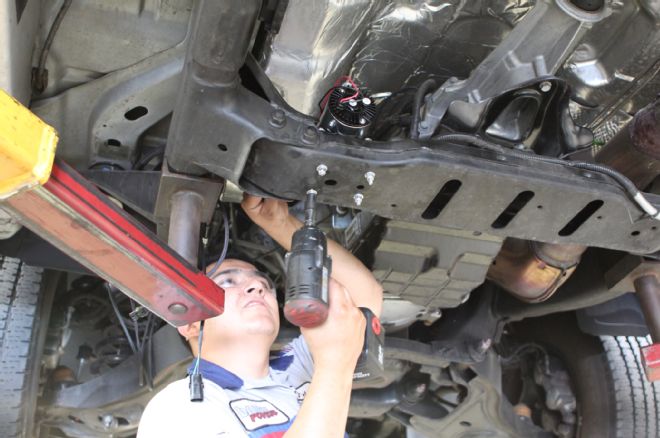
| 2012 Ram 2500 08 Double Shot Water Methanol Injection System
The delivery pump for the Double-Shot water-methanol injection system was mounted on the transmission crossmember, where it should be protected from road hazards.
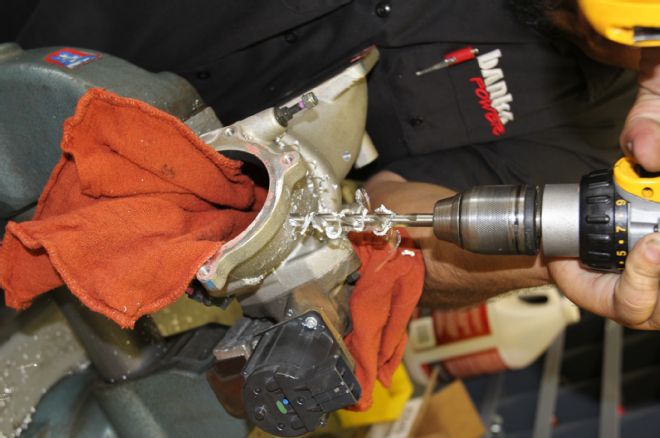
| 2012 Ram 2500 09 Three Holes Were Drilled
Three holes were drilled and tapped in the intake for the water-methanol injection nozzles.
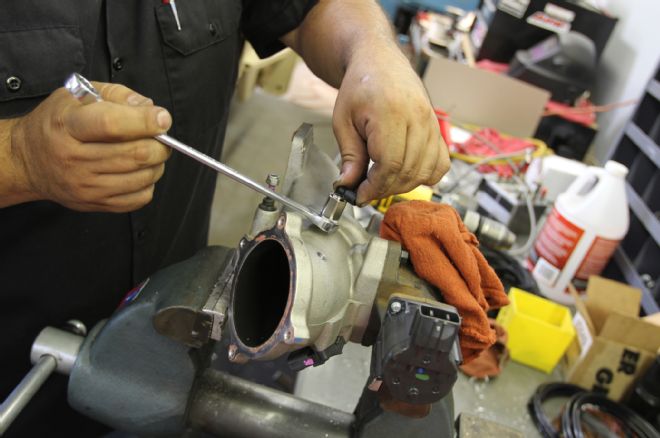
| 2012 Ram 2500 10 Injection Holes
Multipurpose oil was applied to the tap before the injection holes were turned to assure the threads would be smooth.
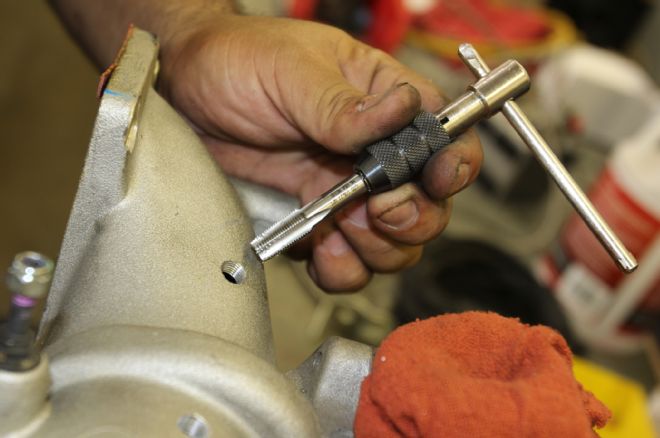
| 2012 Ram 2500 11 Nozzles Had Good Seals
For this application, nozzles with flow ratings of 7, 10, and 14 gph at 100 psi were used. Teflon pipe tape was wrapped around the threads to make sure the nozzles had good seals.
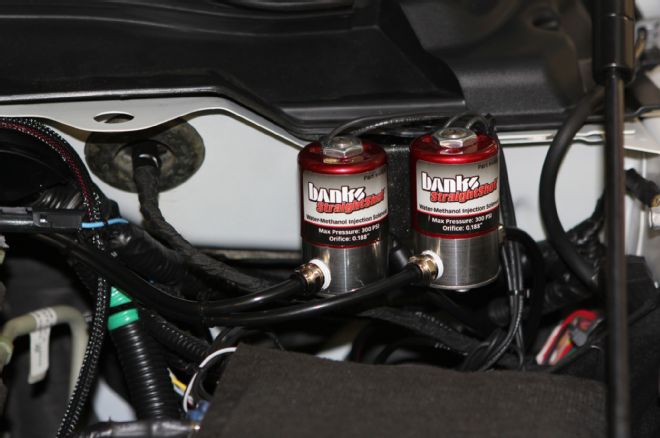
| 2012 Ram 2500 12 Strightshot
As the name implies, the Double-Shot has two stages of progressive water-methanol injection, which are operated by two solenoids mounted to a bracket on the firewall. When the Ram was tested with the water-methanol engaged but without any engine programming in play, the 6.7L put down 422 hp at 3,050 rpm and 869 lb-ft of torque at 2,250 rpm.
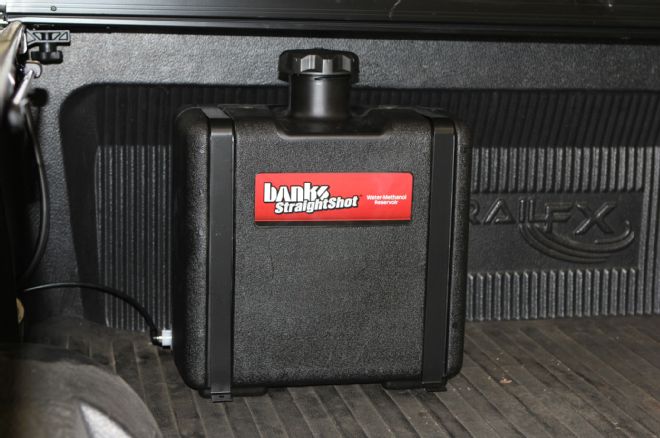
| 2012 Ram 2500 13 Banks Stright Shot
A 7-gallon water-methanol tank was installed in the pickup box and filled with Banks PowerBlend fluid, which is 50 percent water, 49 percent methanol, and 1 percent additives to prevent corrosion.
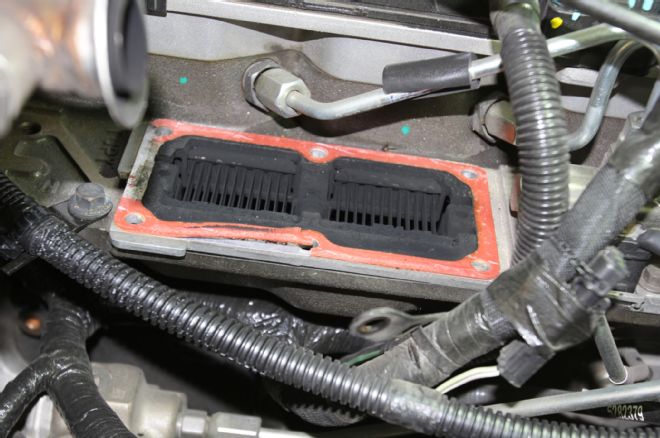
| 2012 Ram 2500 14 Intake Gasket
You don’t have to remove the intake to make holes for the water-methanol injectors, but doing so makes it easier to drill and tap them straight. Plus, the technician, Erick Palma, predicted that the intake gasket was compromised—and he was right.
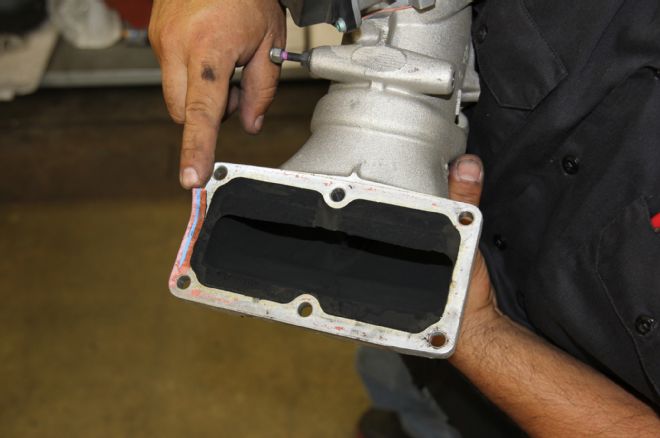
| 2012 Ram 2500 15 EGR Soot Buildup
Erick said he’s seen the same problem on multiple other 6.7L engines, and it was always the left side of the gasket, just like you see here. From the look of the EGR soot buildup inside the intake, it appears the left side does not flow as well, causing the relatively hot EGR gases to build up and wear out the gasket.
Waking the Sleeper
With all the upgrades in place, it was time to wake up the 6.7L Cummins engine and see what it could really do. Dyno runs with the programmer, water-methanol, cold-air intake, and exhaust upgrades resulted in 489 hp and 941 lb-ft of torque making it to the rear wheels. That’s a gain of 203 hp and 349 lb-ft of torque over stock. That makes smoking the rear tires quite easy, but you’d never know just by looking at the truck.
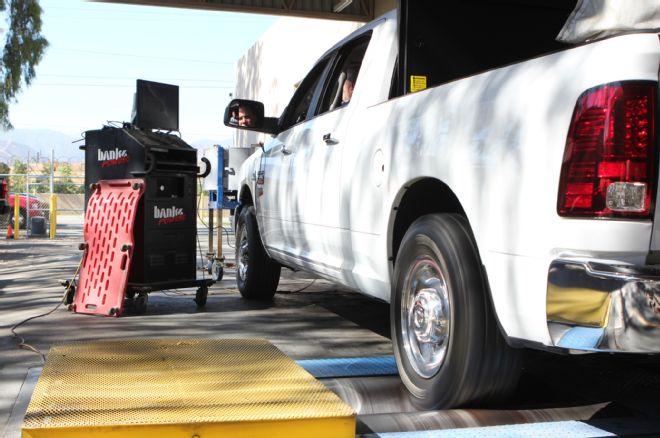
| 2012 Ram 2500 16 On The Dyno
With all the upgrades in place, the 2012 Ram 2500 was pulled back onto the dyno for a final set of tests. With the water-methanol system engaged and the engine tuner on, the truck was able to spin the dyno drum with 489 hp at 2,800 rpm and 941 lb-ft of torque at 2,350 rpm. That meant this 6.7L super sleeper picked up an impressive 203 hp and 349 lb-ft of torque with upgrades that don’t require the use of any specialized tools for installation.
Stock Stock Intake & Exhaust Intake & Exhaust Intake & Exhaust+ Tuner Intake & Exhaust+ Tuner
RPM
HP TQ HP TQ HP TQ
1,550 34 114 89 305 64 215
1,600 68 220 90 299 84 274
1,650 79 248 104 335 99 313
1,700 95 293 116 362 113 348
1,750 103 309 129 394 133 398
1,800 117 340 138 409 150 436
1,850 128 363 151 435 169 478
1,900 141 389 168 473 189 521
1,950 153 412 185 507 211 567
2,000 171 447 207 555 234 613
2,050 194 495 235 614 251 641
2,100 213 532 252 643 267 666
2,150 246 599 260 648 286 698
2,200 257 613 267 653 307 731
2,250 271 625 276 659 320 745
2,300 273 622 284 664 335 762
2,350 282 625 293 667 341 761
2,400 283 618 291 655 350 764
2,450 288 616 297 654 357 763
2,500 293 614 307 665 368 774
2,550 295 607 309 658 369 760
2,600 302 608 313 653 374 753
2,650 304 604 314 645 379 750
2,700 302 593 312 629 383 743
2,750 299 571 312 618 387 737
2,800 300 561 316 616 386 723
2,850 299 550 315 605 390 717
2,900 301 545 316 596 394 712
2,950 297 527 316 588 391 695
3,000 297 520 316 578 402 704
3,050 300 515 319 574 398 684
3,100 293 496 312 555 400 677
3,150 278 464 296 519 390 649
3,200 271 447 289 504 384 629
Intake & Exhaust+ Water-Meth Intake & Exhaust+ Water-Meth Intake & Exhaust+ Tuner + Water-Meth Intake & Exhaust+ Tuner + Water-Meth Difference Difference
RPM
HP TQ HP TQ HP TQ
1,550 60 202 89 299 55 185
1,600 63 207 92 300 24 80
1,650 91 286 108 340 29 92
1,700 104 321 126 389 31 96
1,750 117 351 145 434 42 125
1,800 136 395 162 473 45 133
1,850 150 426 183 517 55 154
1,900 171 470 204 560 63 171
1,950 196 524 229 613 76 201
2,000 227 590 253 663 82 216
2,050 262 667 272 695 78 200
2,100 269 671 291 725 78 193
2,150 288 701 326 791 80 192
2,200 321 764 363 862 106 249
2,250 378 869 399 926 128 301
2,300 378 863 406 923 133 301
2,350 383 856 421 941 139 316
2,400 390 850 416 909 133 291
2,450 396 847 425 909 137 293
2,500 399 836 439 920 146 306
2,550 404 830 446 916 151 309
2,600 406 818 455 915 153 307
2,650 409 808 466 921 162 317
2,700 414 805 468 908 166 315
2,750 416 793 481 916 182 345
2,800 415 777 489 910 189 349
2,850 419 771 486 894 187 344
2,900 421 762 485 878 184 333
2,950 419 744 485 862 188 335
3,000 420 734 482 842 185 322
3,050 422 724 482 828 182 313
3,100 413 699 474 802 181 306
3,150 403 671 473 788 195 324
3,200 389 639 474 776 203 329
 | 2012 Ram 2500 02 Stock Intake
One of the first steps for the sleeper buildup was to get rid of the restrictive factory airbox and air filter. Even with a fairly dirty air filter in place, a session on the chassis dyno proved the stock 2012 Ram 6.7L Cummins was capable of making 304 hp at 2,650 rpm and 625 lb-ft of torque at 2,250 rpm.
| 2012 Ram 2500 02 Stock Intake
One of the first steps for the sleeper buildup was to get rid of the restrictive factory airbox and air filter. Even with a fairly dirty air filter in place, a session on the chassis dyno proved the stock 2012 Ram 6.7L Cummins was capable of making 304 hp at 2,650 rpm and 625 lb-ft of torque at 2,250 rpm.
 | 2012 Ram 2500 03 Banks Intake
| 2012 Ram 2500 03 Banks Intake
 | 2012 Ram 2500 04 Exhuast
The Banks Monster exhaust for the 2012 Ram 2500 replaces everything from the diesel particulate filter back with a 4-inch-diameter, mandrel-bent tube. This setup retains the DPF, so the truck should have no problem passing a California smog test. The owner chose the single 5-inch round exhaust tip to maintain a low profile.
| 2012 Ram 2500 04 Exhuast
The Banks Monster exhaust for the 2012 Ram 2500 replaces everything from the diesel particulate filter back with a 4-inch-diameter, mandrel-bent tube. This setup retains the DPF, so the truck should have no problem passing a California smog test. The owner chose the single 5-inch round exhaust tip to maintain a low profile.
 | 2012 Ram 2500 17 Exhuast
| 2012 Ram 2500 17 Exhuast
 | 2012 Ram 2500 05 Exhuast
The exhaust kit chosen for the 6.7L sleeper is a single-side exhaust, but the Monster exhaust is also available with dual tips on one side of the truck, a single exhaust tip on both sides, or dual tips on both sides of the truck. With the intake and exhaust upgrades, our dyno test showed gains of 15 hp and 42 lb-ft of torque before any upgrades were made to the computer programming.
| 2012 Ram 2500 05 Exhuast
The exhaust kit chosen for the 6.7L sleeper is a single-side exhaust, but the Monster exhaust is also available with dual tips on one side of the truck, a single exhaust tip on both sides, or dual tips on both sides of the truck. With the intake and exhaust upgrades, our dyno test showed gains of 15 hp and 42 lb-ft of torque before any upgrades were made to the computer programming.
 | 2012 Ram 2500 06 Banks Iq Tunner
| 2012 Ram 2500 06 Banks Iq Tunner
 | 2012 Ram 2500 07 Banks Network Hub
Spray Down
While that power rating would be fine for most people, the team at Banks wanted to see what could be accomplished with a healthy dose of water-methanol injection from their Double-Shot system. Three ports were drilled into the intake for the nozzles that are fed by two solenoids, which each have a maximum output of 300 psi. The Straight-Shot controller was mounted to the inside of the windshield next to the iQ 2.0. To get an idea of how much power the water-methanol adds to the sleeper setup, the engine programmer was set to the stock calibration before the water-methanol test. When the truck was pulled back onto the dyno, the results were 422 hp and 869 lb-ft of torque, which is a jump of 118 hp and 244 lb-ft compared to the factory the configuration.
| 2012 Ram 2500 07 Banks Network Hub
Spray Down
While that power rating would be fine for most people, the team at Banks wanted to see what could be accomplished with a healthy dose of water-methanol injection from their Double-Shot system. Three ports were drilled into the intake for the nozzles that are fed by two solenoids, which each have a maximum output of 300 psi. The Straight-Shot controller was mounted to the inside of the windshield next to the iQ 2.0. To get an idea of how much power the water-methanol adds to the sleeper setup, the engine programmer was set to the stock calibration before the water-methanol test. When the truck was pulled back onto the dyno, the results were 422 hp and 869 lb-ft of torque, which is a jump of 118 hp and 244 lb-ft compared to the factory the configuration.
 | 2012 Ram 2500 08 Double Shot Water Methanol Injection System
The delivery pump for the Double-Shot water-methanol injection system was mounted on the transmission crossmember, where it should be protected from road hazards.
| 2012 Ram 2500 08 Double Shot Water Methanol Injection System
The delivery pump for the Double-Shot water-methanol injection system was mounted on the transmission crossmember, where it should be protected from road hazards.
 | 2012 Ram 2500 09 Three Holes Were Drilled
Three holes were drilled and tapped in the intake for the water-methanol injection nozzles.
| 2012 Ram 2500 09 Three Holes Were Drilled
Three holes were drilled and tapped in the intake for the water-methanol injection nozzles.
 | 2012 Ram 2500 10 Injection Holes
Multipurpose oil was applied to the tap before the injection holes were turned to assure the threads would be smooth.
| 2012 Ram 2500 10 Injection Holes
Multipurpose oil was applied to the tap before the injection holes were turned to assure the threads would be smooth.
 | 2012 Ram 2500 11 Nozzles Had Good Seals
For this application, nozzles with flow ratings of 7, 10, and 14 gph at 100 psi were used. Teflon pipe tape was wrapped around the threads to make sure the nozzles had good seals.
| 2012 Ram 2500 11 Nozzles Had Good Seals
For this application, nozzles with flow ratings of 7, 10, and 14 gph at 100 psi were used. Teflon pipe tape was wrapped around the threads to make sure the nozzles had good seals.
 | 2012 Ram 2500 12 Strightshot
As the name implies, the Double-Shot has two stages of progressive water-methanol injection, which are operated by two solenoids mounted to a bracket on the firewall. When the Ram was tested with the water-methanol engaged but without any engine programming in play, the 6.7L put down 422 hp at 3,050 rpm and 869 lb-ft of torque at 2,250 rpm.
| 2012 Ram 2500 12 Strightshot
As the name implies, the Double-Shot has two stages of progressive water-methanol injection, which are operated by two solenoids mounted to a bracket on the firewall. When the Ram was tested with the water-methanol engaged but without any engine programming in play, the 6.7L put down 422 hp at 3,050 rpm and 869 lb-ft of torque at 2,250 rpm.
 | 2012 Ram 2500 13 Banks Stright Shot
A 7-gallon water-methanol tank was installed in the pickup box and filled with Banks PowerBlend fluid, which is 50 percent water, 49 percent methanol, and 1 percent additives to prevent corrosion.
| 2012 Ram 2500 13 Banks Stright Shot
A 7-gallon water-methanol tank was installed in the pickup box and filled with Banks PowerBlend fluid, which is 50 percent water, 49 percent methanol, and 1 percent additives to prevent corrosion.
 | 2012 Ram 2500 14 Intake Gasket
You don’t have to remove the intake to make holes for the water-methanol injectors, but doing so makes it easier to drill and tap them straight. Plus, the technician, Erick Palma, predicted that the intake gasket was compromised—and he was right.
| 2012 Ram 2500 14 Intake Gasket
You don’t have to remove the intake to make holes for the water-methanol injectors, but doing so makes it easier to drill and tap them straight. Plus, the technician, Erick Palma, predicted that the intake gasket was compromised—and he was right.
 | 2012 Ram 2500 15 EGR Soot Buildup
Erick said he’s seen the same problem on multiple other 6.7L engines, and it was always the left side of the gasket, just like you see here. From the look of the EGR soot buildup inside the intake, it appears the left side does not flow as well, causing the relatively hot EGR gases to build up and wear out the gasket.
| 2012 Ram 2500 15 EGR Soot Buildup
Erick said he’s seen the same problem on multiple other 6.7L engines, and it was always the left side of the gasket, just like you see here. From the look of the EGR soot buildup inside the intake, it appears the left side does not flow as well, causing the relatively hot EGR gases to build up and wear out the gasket.
 | 2012 Ram 2500 16 On The Dyno
With all the upgrades in place, the 2012 Ram 2500 was pulled back onto the dyno for a final set of tests. With the water-methanol system engaged and the engine tuner on, the truck was able to spin the dyno drum with 489 hp at 2,800 rpm and 941 lb-ft of torque at 2,350 rpm. That meant this 6.7L super sleeper picked up an impressive 203 hp and 349 lb-ft of torque with upgrades that don’t require the use of any specialized tools for installation.
| 2012 Ram 2500 16 On The Dyno
With all the upgrades in place, the 2012 Ram 2500 was pulled back onto the dyno for a final set of tests. With the water-methanol system engaged and the engine tuner on, the truck was able to spin the dyno drum with 489 hp at 2,800 rpm and 941 lb-ft of torque at 2,350 rpm. That meant this 6.7L super sleeper picked up an impressive 203 hp and 349 lb-ft of torque with upgrades that don’t require the use of any specialized tools for installation.